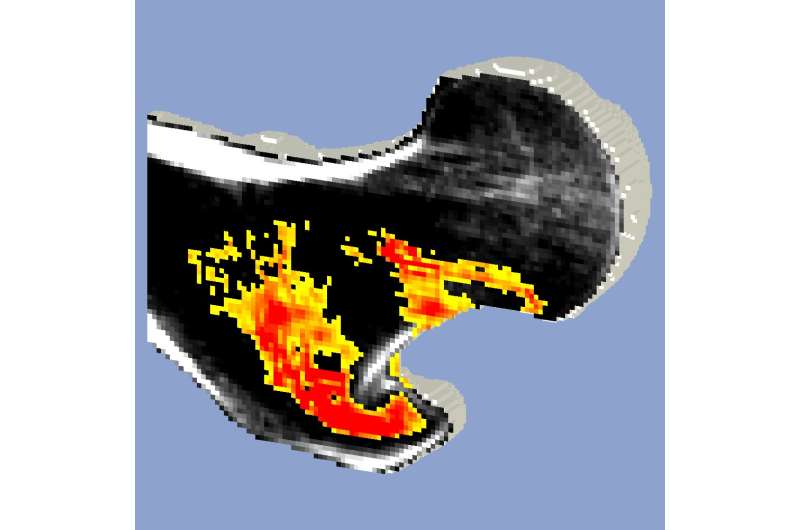Virtual stress testing at the hip by finite element analysis for a simulated sideways fall. Grey regions depict bone density (white is more dense tissue) and colored regions depict failed bone tissue. Credit: Dr. David Lee, O.N. Diagnostics, Berkeley, CA.
A new International Osteoporosis Foundation (IOF) position paper reviews experimental and clinical evidence showing that hip bone strength estimated by bone mineral density (BMD) and/or finite element analysis (FEA) reflects the actual strength of the proximal femur. The paper "Perspectives on the non-invasive evaluation of femoral strength in the assessment of hip fracture risk," published in Osteoporosis International, is authored by experts from the IOF Working Group on Hip Bone Strength as a Therapeutic Target.
Professor Serge Ferrari, corresponding author and co-chair of the IOF Working Group, noted: "With the number of debilitating hip fractures increasing worldwide, there is a pressing need to prioritize the development of accurate methods for estimating bone strength in vivo and predicting hip fracture risks. Validation of surrogate endpoints for fracture could potentially lead to shorter and less expensive clinical trials, possibly spurring innovations of new drugs and procedures which might otherwise not be investigated due to the high cost of conducting a clinical trial with fracture outcomes."
The authors extensively reviewed relevant experimental and clinical studies, examining associations between experimentally measured femoral strength and areal BMD or FEA estimated strength; surrogates of hip strength (densitometric and structural variables, and FEA); predictive power for hip fracture of computed-tomography (CT)-based and DXA-based FE approaches; effects of osteoporosis treatment on bone mass, FEA and bone strength in pre-clinical studies; and effects of osteoporosis treatment on FEA estimates of bone strength in clinical trials.
Virtual stress testing at the hip by finite element analysis for a simulated sideways fall. Grey regions depict bone density (white is more dense tissue) and colored regions depict failed bone tissue. Credit: Dr. David Lee, O.N. Diagnostics, Berkeley, CA.
Professor Mary L. Bouxsein, first author of the paper and Working Group co-chair, stated: "The findings of this extensive review confirm that femoral areal BMD and bone strength estimates by CT-FEA are good predictors of fracture risk and are excellent candidates to replace fracture endpoints in clinical trials."
The authors also conclude that further improvements of FEA may be achieved by incorporating trabecular orientations, enhanced cortical modelling, effects of aging on bone tissue ductility, and multiple sideway fall loading conditions.
More information: Mary Bouxsein et al, Perspectives on the non-invasive evaluation of femoral strength in the assessment of hip fracture risk, Osteoporosis International (2020). DOI: 10.1007/s00198-019-05195-0
Journal information: Osteoporosis International
Provided by International Osteoporosis Foundation





















